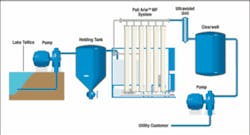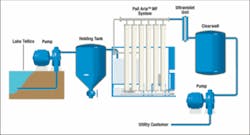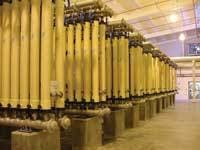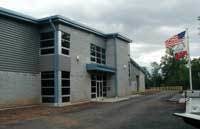Utility Selects Membrane System for First Water Treatment Plant
The South Blount County Utility District (SBCUD) provides drinking water to approximately 12,000 customers in eastern Tennessee. Until 2004, it purchased potable water from two utilities in neighboring cities, each of which processed water using conventional surface water treatment. Two-thirds of the water was purchased from one of the two utilities, but that supplier raised rates substantially over a two-year period − from $.97 to $2.41 per 1000 gallons. The other utility did not have the resources to provide the quantity of water needed. SBCUD was averaging 2.5-3 mgd at the time.
For SBCUD, the high cost of water and the expectation of additional price increases was enough to warrant the construction of its own municipal water treatment plant (WTP). Additionally, the county was growing and a sufficient water supply had to be secured.
“When purchasing water from the other utilities, there was always the possibility of shortages, especially in the summer when watering lawns and filling swimming pools almost doubled consumption,” said Henry Durant, District Manager at SBCUD.
In 2001, SBCUD had 10,000 customers; by 2004 this number increased to 13,000. Owning a treatment facility would provide SBCUD with a reliable water supply and substantial cost savings.
New Facility
The plan was to build the WTP on Lake Tellico, a hydroelectric reservoir in Blount County. The lake was chosen as the water source because it is a protected watershed and is large enough to supply the community with the amount of water it needs.
The SBCUD Board of Directors hired an engineering firm to design the physical plant and to determine the most viable water treatment technology. Based on preliminary water sampling and a desktop treatment evaluation, it was determined that microfiltration/ultrafiltration followed by ultraviolet (UV) disinfection would be the preferred treatment.
Pall Corp. was awarded a contract to design and install a pilot microfiltration system for the production of low turbidity finished water from Lake Tellico. The Pall Aria pilot system had the same size membrane modules as the full-scale system design, so it accurately simulated the operation and performance of a full-scale unit during production of 15 gal/min.
“The pilot system performed exceptionally well during the test period and exceeded expectations for turbidity, flux, and recovery,” Durant said.
Filtrate turbidity was measured at < 0.1 NTU; flux at 40 gfd; and recovery at 96%.
Based on the success of the pilot test, as well as other factors, SBCUD selected Pall to build the full-scale microfiltration system. Other factors considered were technical expertise, membrane compatibility, ease of system operation, reliable integrity testing, and economics.
The full-scale Pall Aria system consists of four hundred 0.1 μm hollow fiber membrane modules in six membrane trains. At the request of the utility, it was designed with a capacity of 8 mgd and the capability of being expanded to 12 mgd by adding membranes and pumps. The system can also be expanded to produce 24 mgd by adding six more membrane trains. Having the system designed with expansion capabilities was a proactive measure to accommodate future increases in population.
Processing water from Lake Tellico involves pumping it uphill to a raw water storage tank, from where it is sent to the WTP. The water passes through the membrane system and the UV disinfection unit, then exits the plant to a clear well, where it is dosed with chlorine manufactured at the plant. Chlorine is the only chemical used in the treatment process.
With the official opening of the J. Isom Lail Memorial Water Treatment Plant in October 2004, the South Blount utility became the first in Eastern Tennessee to use membrane filtration for a municipal water supply.
The completed project cost the utility $18 million, but it was money well spent, Durant said.
The quality of the water treated at the SBCUD plant is superior to that previously purchased from the neighboring utility. Together with the UV disinfection unit, the membrane system produces high-quality, low turbidity water that remains constant under all conditions and complies with EPA guidelines for drinking water.
“The utility has been saving approximately $100,000 per month in water costs since the plant became operational,” Durant said.




